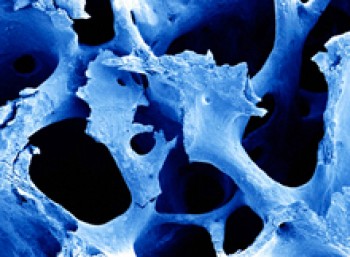New Method Builds Bone
New Method Builds Bone
Researchers have developed a way to direct the body’s own stem cells to the outer bone to build new, strong bone tissue. The method, developed in mice, may lead to new treatments for osteoporosis and other bone diseases that affect millions of people.

Scanning electron micrograph of osteoporotic bone. Image by David Gregory and Debbie Marshall. All rights reserved by Wellcome Images.
Bones are made of a mineral and protein scaffold filled with bone cells. Bone tissues continually break down and build back up again. When the rate of bone loss outpaces the rate of bone tissue replacement, bones weaken, eventually leading to osteoporosis. This is common in people as they age.
Osteoblasts, the cells that rebuild bone, are derived from mesenchymal stem cells. These stem cells are found in bone marrow, deep inside the bone. They transform into osteoblasts and migrate to the outer bone, where they create new bone tissue.
As we age, we lose mesenchymal stem cells, so bone tissue building slows down. A team of researchers led by Dr. Wei Yao of the University of California, Davis sought to build new bone tissue by directing mesenchymal stem cells to outer bone more quickly. Their work was funded by several NIH components, including the National Institute of Arthritis and Musculoskeletal and Skin Diseases (NIAMS), Eunice Kennedy Shriver National Institute of Child Health and Human Development (NICHD) and National Institute on Aging (NIA). The results appeared in the online edition of Nature Medicine on February 5, 2012.
Mesenchymal stem cells express a surface protein called α4β1 integrin as they turn into osteoblasts. This protein helps them stick to bone and tissue surfaces. The scientists reasoned that a linker binding to both the α4β1 integrins and the outer bone surface would encourage the cells to stick to the outer bone.
The researchers created a hybrid compound from 2 molecules: LLP2A, a protein-like molecule that sticks to α4β1 integrins, and alendronate, an osteoporosis drug that sticks to the outer surface of bones. They called the compound LLP2A-Ale.
After 4 weeks of treatment with LLP2A-Ale, the bones of healthy mice were stronger and had more bone tissue than those of mice treated with alendronate alone or saline. In mice with weakened bone, the compound prevented further bone loss. Because mice, like humans, lose bone as they age, the scientists also treated older mice with LLP2A-Ale. The compound increased bone tissue in the older mice and prevented age-related bone loss.
The rate of bone loss can rise steeply in women after menopause. This is because levels of estrogen, a hormone important for maintaining bone health, begin to drop. To see if LLP2A-Ale could reverse bone loss when estrogen is low, the researchers infused estrogen-deficient female mice with LLP2A-Ale or parathyroid hormone, a molecule that increases bone formation. They found that LLP2A-Ale was as effective as parathyroid hormone at increasing the rate of bone formation.
“For the first time, we may have potentially found a way to direct a person’s own stem cells to the bone surface where they can regenerate bone,” says co-investigator Dr. Nancy Lane of UC Davis. “This technique could become a revolutionary new therapy for osteoporosis as well as for other conditions that require new bone formation.”
More studies will be needed, however, before the compound is ready for human trials.
By Lesley Earl, Ph.D.
###
* The above story is reprinted from materials provided by National Institutes of Health (NIH)
** The National Institutes of Health (NIH) , a part of the U.S. Department of Health and Human Services, is the nation’s medical research agency—making important discoveries that improve health and save lives. The National Institutes of Health is made up of 27 different components called Institutes and Centers. Each has its own specific research agenda. All but three of these components receive their funding directly from Congress, and administrate their own budgets.




















